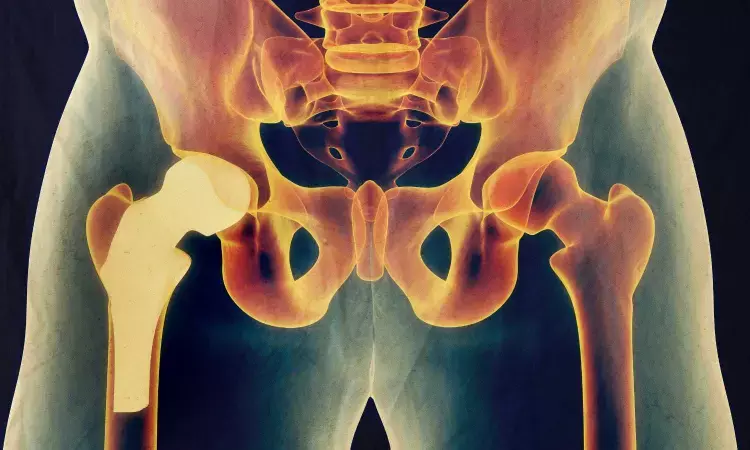- Home
- Medical news & Guidelines
- Anesthesiology
- Cardiology and CTVS
- Critical Care
- Dentistry
- Dermatology
- Diabetes and Endocrinology
- ENT
- Gastroenterology
- Medicine
- Nephrology
- Neurology
- Obstretics-Gynaecology
- Oncology
- Ophthalmology
- Orthopaedics
- Pediatrics-Neonatology
- Psychiatry
- Pulmonology
- Radiology
- Surgery
- Urology
- Laboratory Medicine
- Diet
- Nursing
- Paramedical
- Physiotherapy
- Health news
- Fact Check
- Bone Health Fact Check
- Brain Health Fact Check
- Cancer Related Fact Check
- Child Care Fact Check
- Dental and oral health fact check
- Diabetes and metabolic health fact check
- Diet and Nutrition Fact Check
- Eye and ENT Care Fact Check
- Fitness fact check
- Gut health fact check
- Heart health fact check
- Kidney health fact check
- Medical education fact check
- Men's health fact check
- Respiratory fact check
- Skin and hair care fact check
- Vaccine and Immunization fact check
- Women's health fact check
- AYUSH
- State News
- Andaman and Nicobar Islands
- Andhra Pradesh
- Arunachal Pradesh
- Assam
- Bihar
- Chandigarh
- Chattisgarh
- Dadra and Nagar Haveli
- Daman and Diu
- Delhi
- Goa
- Gujarat
- Haryana
- Himachal Pradesh
- Jammu & Kashmir
- Jharkhand
- Karnataka
- Kerala
- Ladakh
- Lakshadweep
- Madhya Pradesh
- Maharashtra
- Manipur
- Meghalaya
- Mizoram
- Nagaland
- Odisha
- Puducherry
- Punjab
- Rajasthan
- Sikkim
- Tamil Nadu
- Telangana
- Tripura
- Uttar Pradesh
- Uttrakhand
- West Bengal
- Medical Education
- Industry
Arthroscopy for borderline hip dysplasia provides positive long-term outcomes in young adults

USA: A recent study has reported that primary arthroscopy improves symptoms and function, provides long-term outcomes in young adults with borderline hip dysplasia (BHD), and avoids the need for hip replacement in most cases. The study appears in The Journal of Bone & Joint Surgery.
Primary arthroplasty for BHD was also associated with significant improvement in standard patient-reported outcome measurements, including pain and hip function. For example, three-fourths of patients met the minimum clinically important difference for improvement in pain score.
The study, with a ten-year follow-up, provides new evidence on the benefits of arthroscopy for the treatment of BHD, according to the case series by Benjamin G. Domb, MD, of the American Hip Institute, Chicago.
New data on arthroscopy as less-invasive alternative for BHD
BHD is a congenital condition in which the hip socket does not fully cover the ball-like femoral head. Symptoms such as pain, limping, and hip instability often do not develop until young adulthood. Over time, patients with BHD risk developing osteoarthritis, in many cases leading to total hip arthroplasty (THA).
There is ongoing controversy regarding the best treatment for BHD. The standard treatment is surgery (periacetabular osteotomy) to reconstruct and reposition the hip joint. Arthroscopy has emerged as a less-invasive alternative procedure, with studies showing improvement in symptoms and hip function at short- to medium-term follow-up. However, because of a lack of long-term follow-up data, it has been unclear whether arthroscopy is a "temporary or definitive solution," according to the authors.
To address this question, Dr. Domb and colleagues report their experience with primary arthroscopic surgery for BHD. Typical of patients requiring BHD treatment, the patients were young (mean age, 31 years) and predominantly female (38 of 45 patients). All patients met standard radiographic criteria for BHD diagnosis (i.e., a lateral center-edge angle between 18° and 25°).
Arthroscopic surgery included tightening (plication) of the joint capsule and preservation of the cartilage lining the labrum. All patients had 10-year follow-up data to assess the need for conversion to THA as well as patient-reported ratings of symptoms and hip function.
Follow-up shows low rate of THA conversion, good clinical improvement
Eight of the 35 patients underwent THA during follow-up, performed at an average of about five and a half years after arthroscopy. On Kaplan-Meier analysis, estimated "survivorship" was 82.8% – about four out of five patients with BHD could expect to remain free of THA for at least 10 years after primary arthroscopy. This rate was compared favourably to a matched control group of patients without BHD.
Patients who required THA were older and heavier than those who did not. After adjustment for other factors, the likelihood of THA was 4.4 times higher for patients with a body mass index of 23 kg/m2 or greater and 7.1 times higher for those 42 years or older.
Primary arthroplasty for BHD was also associated with significant improvement in standard patient-reported outcome measurements, including pain and hip function. For example, three-fourths of patients met the minimum clinically important difference for improvement in pain score.
Building on previous short- to medium-term studies, the study adds new evidence showing good long-term outcomes following primary arthroplasty for BHD. In addition to a low conversion rate to THA over a 10-year follow-up, less-invasive treatment with arthroscopy also avoids the longer recovery time required by standard surgery for BHD.
Reference:
Domb, Benjamin G.,Owens, Jade S. BS1; Glein, Rachel M. BS1; Jimenez, Andrew E. MD1; Maldonado, David R. MD1. Borderline Dysplasia After Primary Hip Arthroscopy with Capsular Plication and Labral Preservation: Ten-Year Survivorship and Patient-Reported Outcomes. The Journal of Bone and Joint Surgery ():10.2106/JBJS.22.00340, April 21, 2023. | DOI: 10.2106/JBJS.22.00340
Dr Kamal Kant Kohli-MBBS, DTCD- a chest specialist with more than 30 years of practice and a flair for writing clinical articles, Dr Kamal Kant Kohli joined Medical Dialogues as a Chief Editor of Medical News. Besides writing articles, as an editor, he proofreads and verifies all the medical content published on Medical Dialogues including those coming from journals, studies,medical conferences,guidelines etc. Email: drkohli@medicaldialogues.in. Contact no. 011-43720751


